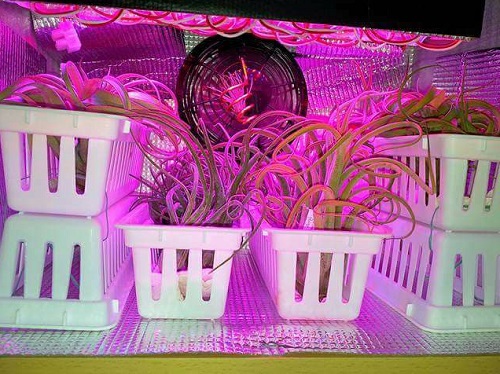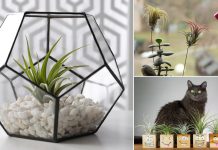Do Air Plants Need Sun? Find the answer and learn how to give them the right amount of light for the vibrant air plants!
Air plants, also known as Tillandsia, are intriguing creatures of the plant world. Many wonder, Do Air Plants Need Sun? In this simple guide, you’ll explore the sunlight requirements of these unique plants and how to keep them thriving in your home, even if you don’t have direct sunlight.
Read About How Long Air Plants Live here
Do Air Plants Need Sun?
Yes, air plants do need sunlight, but their sunlight requirements are different from those of traditional potted plants. Air plants, also known as Tillandsia, are unique because they don’t require soil to grow. Instead, they absorb nutrients and moisture from the air, making them adaptable to various light conditions. Here’s how air plants’ sunlight needs work:
- Indirect Light: Air plants prefer bright, indirect light. They are not accustomed to direct sunlight, which can scorch their leaves. To provide the right amount of light, place your air plant near a window with sheer curtains or on a windowsill that receives filtered sunlight.
- Filtered Sunlight: If you live in a location with intense sunlight, it’s crucial to filter the light. Placing your air plant behind a sheer curtain or using frosted glass can help diffuse the sunlight and prevent sunburn.
- Artificial Light: If natural light is insufficient, you can use artificial light sources, such as fluorescent or LED grow lights. Position the lights about 6 to 12 inches above your air plants and keep them on for about 12 to 14 hours a day.
- Rotate Regularly: To ensure even growth and prevent one side of the plant from receiving more light than the other, rotate your air plant every few weeks. This helps maintain its health and symmetry.
- Shade Tolerance: While air plants do need light, they can tolerate lower light conditions for short periods. However, extended periods of insufficient light will weaken the plant and eventually lead to its demise.
- Avoid Hot Afternoon Sun: Be cautious of exposing your air plants to hot afternoon sun, especially in warmer climates. The intense heat can quickly damage the delicate leaves.
Read About How Big do Air Plants Get here
Use of Artificial Light for Air Plants

Air plants need sun for healthy growth; in the absence of that, artificial light can be used for Tillandsia. It can effectively provide them with the necessary light they need for growth. These epiphytes are unique because they don’t require soil to grow, but air plants do need adequate sun for photosynthesis, which is essential for their survival and overall health.
Here’s how you can use artificial light for air plants:
1. Choose the Right Light Source:
- Full-spectrum LED grow lights are the most suitable option for air plants. They provide a balanced spectrum of light that mimics natural sunlight and promotes healthy growth.
- T5 fluorescent lights and compact fluorescent bulbs can also be used, but they may not be as energy-efficient or as effective as LED lights.
2. Positioning the Lights:
- Place the artificial light source above or beside your air plants. The light should be close enough to provide sufficient illumination but not so close that it burns or overheats the plants.
- The ideal distance between the light source and the air plants varies depending on the type and intensity of the light. Generally, it’s recommended to keep the light source 6 to 12 inches away from the plants.
3. Duration and Intensity:
- Air plants typically require around 12 to 16 hours of light each day. You can use a timer to ensure consistent lighting.
- Adjust the intensity of the light as needed. Some air plant species may thrive under lower light levels, while others may require brighter conditions. Pay attention to your specific species’ requirements.
4. Lighting Schedule:
- Consistency is key. Establish a regular lighting schedule for your air plants to mimic natural day and night cycles.
5. Monitor the Plants:
- Regularly check your air plants for signs of stress or overexposure to light. If you notice browning or bleaching of the leaves, adjust the light intensity or duration accordingly.
6. Supplemental Natural Light:
- If possible, supplement the artificial light with some natural sunlight. Air plants do well with indirect sunlight, so placing them near a window with filtered or diffused sunlight can be beneficial.
7. Rotate the Plants:
To ensure even growth and prevent one side of the plant from receiving more light than the other, rotate your air plants every few weeks.
Learn Everything About Air Plant Diseases here
Ideal Placement of Air Plants
1. Bright, Indirect Light:
Air plants thrive in bright, indirect light. This means they should be situated in a location where they receive plenty of ambient or filtered sunlight throughout the day. Ideally, place them near a window with sheer curtains or on a shelf with good light exposure. Avoid direct, intense sunlight, as it can harm their leaves.
2. Indoor Locations:
If you’re keeping air plants indoors, ensure they are near a source of natural light, such as a window. The key is to provide them with bright, indirect sunlight. If your indoor space lacks sufficient natural light, you can use artificial lighting, such as full-spectrum LED grow lights. Position the lights about 6 to 12 inches away from the plants and maintain a lighting schedule of 12 to 16 hours per day.
3. Outdoor Placement:
In regions with suitable temperatures, air plants can thrive outdoors. However, you must find the right balance of light. Partial shade or filtered sunlight is ideal. Too much direct sun, especially during hot afternoons, can lead to sunburn. Protect them from extreme weather conditions like frost or intense heat.
4. Bathroom or Kitchen:
These areas can be suitable for air plants because they tend to have higher humidity levels due to regular use of water. Just ensure that they still receive the appropriate amount of bright, indirect light, as excessive moisture alone may not be sufficient for their growth.
5. Airflow and Ventilation:
Good air circulation is essential for air plants since they absorb nutrients and moisture from the air. Avoid placing them in enclosed containers or terrariums without proper ventilation, as this can lead to rot and mold issues. If you want to display them in enclosed spaces, choose containers with openings or vents.
6. Regular Monitoring:
Regardless of where you place your air plants, it’s crucial to monitor their condition regularly. Look for signs of stress, such as browning or drying of leaves. Adjust their location or care routine accordingly to ensure air plants remain healthy and receive adequate sun.
Check Out the Best Air Plant Terrarium Ideas here
Conclusion- Do Air Plants Need Sun?
In conclusion, air plants indeed need sun, but their sunlight requirements differ from typical potted plants. These fascinating plants can adapt to various light conditions, making them versatile additions to your indoor or outdoor space. To ensure their well-being, provide them with bright, indirect sunlight or use artificial lighting. By understanding their unique needs, you can enjoy the beauty of air plants while allowing them to bask in the sun’s gentle embrace without harm.





